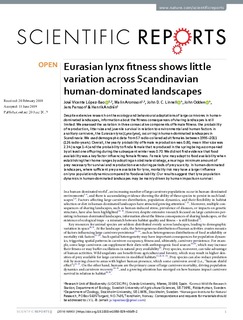Eurasian lynx fitness shows little variation across Scandinavian human-dominated landscapes
López-Bao, José Vicente; Aronsson, Malin; Linnell, John Durrus; Odden, John; Persson, Jens; Andrén, Henrik
Peer reviewed, Journal article
Published version

Åpne
Permanent lenke
http://hdl.handle.net/11250/2604045Utgivelsesdato
2019Metadata
Vis full innførselSamlinger
- Scientific publications [1392]
Originalversjon
10.1038/s41598-019-45569-2Sammendrag
Despite extensive research on the ecology and behavioural adaptations of large carnivores in humandominated landscapes, information about the fitness consequences of sharing landscapes is still limited. We assessed the variation in three consecutive components of female fitness: the probability of reproduction, litter size and juvenile survival in relation to environmental and human factors in a solitary carnivore, the Eurasian lynx (Lynx lynx), occurring in human-dominated landscapes in Scandinavia. We used demographic data from 57 radio-collared adult females between 1995–2011 (126 radio-years). Overall, the yearly probability of female reproduction was 0.80, mean litter size was 2.34 (range 1–4) and the probability to find a female that reproduced in the spring being accompanied by at least one offspring during the subsequent winter was 0.70. We did not find evidence that food availability was a key factor influencing female fitness. Female lynx may adapt to food availability when establishing their home ranges by adopting an obstinate strategy, ensuring a minimum amount of prey necessary for survival and reproduction even during periods of prey scarcity. In human-dominated landscapes, where sufficient prey are available for lynx, mortality risk may have a larger influence on lynx population dynamics compared to food availability. Our results suggest that lynx population dynamics in human-dominated landscapes may be mainly driven by human impacts on survival.
